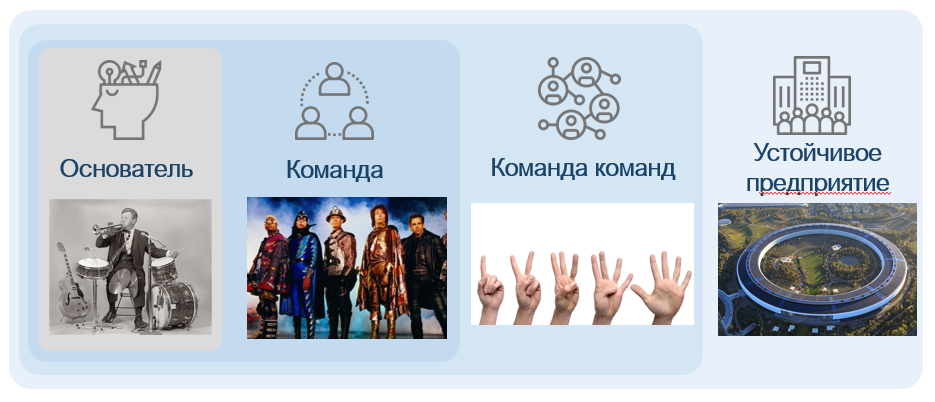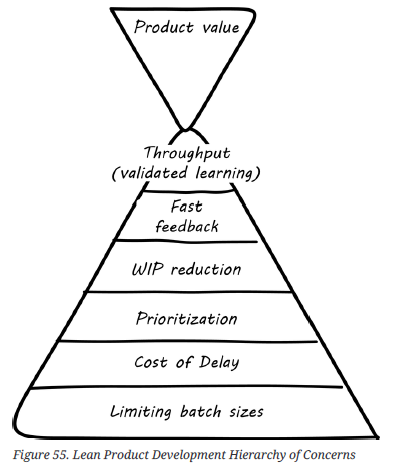I prepared internal methodological material for DPMBoK. In my opinion, this spring it became clear to everyone that today there is almost no business left that does not need to carry out digital transformation, and this post can bring everyone interested in this topic up to date or open an interesting discussion in the comments.

Any enterprise based on elements of a digital business (digital product or service, platform, ecosystem) in the process of growth is faced with moments of slowdown or absence of planned expansion that is unreasonable from the point of view of "classical" management. These moments can be caused by many factors (obstacles, restrictions): external or internal, technical or organizational, solvable or, at first glance, insurmountable. Some of the barriers are typical in a particular industry where solutions can be tried. And restrictions may arise that are not tied to a business model or industry. The explanation for this situation lies in the fact that digital products with a significant IT component are social and technical systems with high complexity. It means,that small changes in their components or interactions can significantly affect their overall behavior and value.
The most unpleasant thing is that such restrictions are akin to a toothache - they would have known earlier, would not have had to drill or remove. Trying to diagnose your enterprise using Internet forums, professional platforms is often an effective, but very labor-intensive way. Seeking professional consultants and experts is a good thing and most likely the right thing to do. But in this case, it is good to “be in the subject” or prepare in advance by studying someone else's experience.
My colleagues and I in the center of strategic development and digital transformation (it operates in the company "LANIT-Integration") are engaged in the creation and operation of digital enterprises and have long formed the methodological basis of our consulting projects. Nevertheless, we were pleasantly surprised by the complementarity and completeness of this body of knowledge. Reading modern business literature today is often a thankless task - there are too many materials, it is hard to find what you need. Individual editions, the meaning of which can be formulated in eight lines of text, are 95% filled with historical and personal excursions set out in the form of essays (like this text).
Many publications focus on specific issues of digital product creation, teamwork, or technical challenges.
For a long time, there were no publications on the market covering all aspects of a digital enterprise. But, as they say, “a holy place is never empty,” and in mid-2019, a group of authors from The Open Group presented the first version of the Digital Practitioner Body of Knowledge , which tried to fit all relevant approaches to solving the most typical and significant challenges. arising before the owners and employees of the digital enterprise.
The set is not just an ontology of methods and terms, but a consistently stated path of the digital enterprise, with the disclosure of the practical experience of using the described tools by real teams and companies.

The vault itself is available in two formats:
- an Internet portal (it will be convenient for those who find it difficult to get acquainted with the material in English and can use the browser translation function, but it is better to get acquainted with the original in parallel ),
- pdf version available for download after registration.
By the way, the presence of a portal is not a whim of The Open Group. One of the principles, which the authors laid in the basis of DPBoK, says: “The body of knowledge itself must exist and develop as a digital product. Developers should have a clear understanding of the audience structure, the effectiveness of delivery channels, the development itself should be carried out at a certain pace, and the content should change due to feedback and interaction with the audience. "
The codex consists of six sections, the first five of which are essentially introductory. They disclose the reasons and purpose of creation, and also provide guidance for use.
The authors provide quite clear arguments why the onset of digitalization is forcing companies to rethink their own business models and strategies.
Many elements of the vault are built on previously created materials by The Open Group. One of the key materials is the principle of seven levers for organizational change - the basic elements required to build a digital enterprise:
- transformation of business processes;
- customer experience and interaction;
- digital transformation of the product;
- transformation of IT and product implementation processes;
- organizational culture;
- strategy;
- ecosystem and business model.

Looking ahead, it is worth noting that DPBoK contains many references to other well-known standards and bodies of knowledge, which underlines the authors' reluctance to reinvent the wheel for every problem presented, while maintaining completeness and coverage.
The authors note that in practice, modern methods of creating a digital product should not be opposed to classical ones. Any time- and community-tested toolkit can be useful over a period of time at the appropriate scale of the enterprise.
Sixth, it is the main and most voluminous part of the body of knowledge built according to the scheme of scaling a digital enterprise: from the tasks of a startup founder to the problems of digital companies.

Each of the stages in which a digital enterprise finds itself contains sections of knowledge of the most relevant problems and approaches to their solution.

| Sustainable enterprise | Architectural approach |
| Information management | |
| Governance, risk management, information security, regulatory compliance | |
| Team of teams | Culture and organization |
| Financing product portfolio | |
| Process approach and management | |
| Command | Technical Operations Management |
| Job management | |
| Product management | |
| Founder | Application delivery |
| Digital product infrastructure | |
| Digital product fundamentals |
The first context (“Founder”) presents the basic set of knowledge and skills required to create a digital product. To a large extent, the material presented is consistent with Lean startup principles: generating ideas, collecting and testing hypotheses, user feedback, creating a plan-build-run cycle. The Digital Foundations section provides a diagram that will be extremely useful in understanding the mechanisms for creating value for the customer, including the concept of the digital product life cycle (idea> investment> development> change> delivery> use> support> recovery> improvement / withdrawal) ...

In the context, the current methods of organizing the technical infrastructure necessary for launching a digital product are given, including issues of virtualization, the use of cloud and hybrid infrastructure, containers and Infrastructure as Code mechanisms.
For dessert, this context invites you to familiarize yourself with agile application development and delivery tools. It is unlikely that regular readers of Habr will find something new here, although a historical excursion into the reasons for the development of iterative development models and DevOps can be useful.
The second context contains a set of techniques and tools necessary for the effective work of small teams that create their own product, including product, work and operations management ("infrastructures" have not been forgotten).
Since the advent of total mobility, it has become clear that teams focused on the technical part of creating a product need to have competencies in managing its consumer value. Understanding the market, constantly looking for user needs and responding to feedback is just as important as product implementation and delivery.
These issues are covered in the product management basics section. There are many useful techniques to be found here. For example, a DIBB model built along the chain “data> insight> conviction> rate” will show the importance of a hypothesis testing mechanism. It will also be helpful to familiarize yourself with the Jobs-to-be-Done product research approach and the Design Thinking concept.

The authors of the code did not pass by the classical approaches associated with identifying requirements for a future product, which were formulated in another specialized body of knowledge BABoK.
Despite the general adherence to lean product development methods, the authors point out the existing limitations in the applicability of these methods. Not all products are social media (flowers) where A / B testing works great. There is still a large proportion of systems engineering products (cogs) that need elaboration of requirements.
A logical continuation of the product development issue is the topic of work management: the moment when your product begins to require the completion of diverse, but related tasks.
Here, the authors of DPBoK took an important action - they explained the relationship of product concepts with the concepts of developing all relevant agile and lean methods: defining the concept of “done”, managing task queues, reducing “unfinished”, prioritizing tasks based on the cost of backlog indicator (the financial side of which can be useful to both engineers and product engineers), etc.

Lean product development is an equally valuable resource. The age-old opinion of programmers that “development is a creative process whose time frame cannot be determined” has found its refutation in the Lean Product and Process Development approach - a set of effective methods that help not to waste valuable time at all stages of development, build a transparent and predictable process. Many of the techniques come from the experience of the Japanese auto industry, which has stood the test of time and the market.
Regarding “operations” (one might say “infrastructure maintenance services”, however, such a translation does not fully reflect the meaning of the term operations), the second context not only defines, but also describes the relationship of “operations” with the product life cycle and user experience. It also defines the concepts of service level, system configurations, media pipeline, and telemetry. All this is stated in a language understandable to a person far from system administration, and can serve as an aid in creating a holistic vision of a digital product.
The usefulness of familiarity with the principles of technical scaling (CAP and AKF) can hardly be overestimated: being absorbed in the processes of development and implementation of a product, at some point you can find yourself very puzzled by the question of system load.
Moving on to the third context “Teams of teams”, I would like to note that this level is characteristic of only a few dozen well-known domestic companies. But despite the ambitiousness of the context, its content will be useful for professionals and entrepreneurs who have begun to think about the development of not only a separate digital product, but the enterprise as a whole.

At this stage, team coordination, financial management, as well as cultural and organizational issues claim to the first place even more. In fact, we can say that these are the main management issues of not only a digital enterprise, but also classical management. It is impossible to ignore the work of Frederick Taylor, Edward Deming, Peter Drucker and other practicing scientists in the field of labor organization. But in this case, the authors of The Open Group do not torment the reader with long studies, but provide a compact and logical explanation of the importance of the scientific organization of labor for the success of a digital enterprise.
An introduction to financial aspects won't hurt anyone. The authors do not put the financial component in the foreground. Yes, businesses must be profitable for their owners. But this rule does not go against the vision and development of digital products.

Cost planning, decision-making based on optimal requirements, ways to attract investment, pricing, as well as the purchase of external services and services - these are not idle issues, they require understanding and approaches to the solution.
This section often features one of the most well-known scalable Agile approaches, SAFe, which itself deserves a whole series of articles, and where goal setting and job definition is based on financial performance.

The organizational context section is organized in the following order: from organizational structures and their filling in the recruitment process to the most complex organizational culture issues.
The fourth context, in fact, describes the topical issues of the existence of the major league of digital enterprises: Yandex, Google, Facebook. Does this mean that this section contains no value for smaller organizations? In no case! The point is that enterprises of this scale no longer exist as isolated systems. They provide platforms and ecosystems for the development of other digital enterprises. Once you become familiar with the context of Sustainable Enterprise, you can understand (and forgive) the demands of the Bigger that you previously thought were whimsy and bureaucracy, adapt your expectations to them, and create more productive interactions.
So why is it worth reading DPBoK
First, it's beautiful. Second, DPBoK provides a comprehensible and valuable squeeze of knowledge related to the creation and growth of a digital enterprise that can be quickly accessed to address emerging challenges. And third, you get a set of the best references on current good practices, with useful insights and essential historical references to give you a fuller understanding of the present moment.
I hope this material will be helpful on your journey towards building your digital enterprise. If you have any questions, I will be glad to answer them in the comments.
Our vacancies